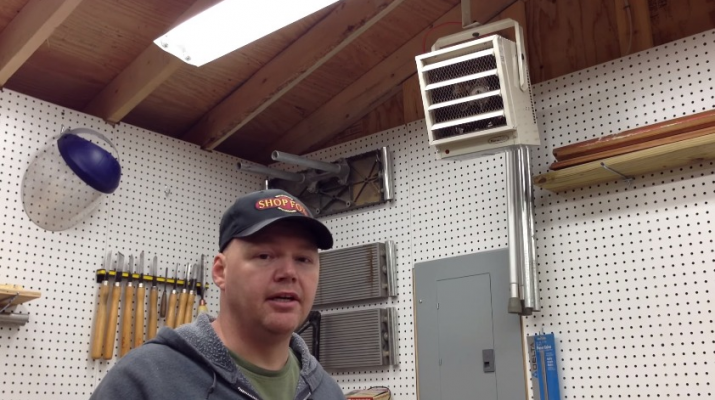How Does a Waste Oil Heater Work?
In a world of waste, many people are seeking solutions to transform that waste into something useful. One increasingly popular trend is to make a homemade waste oil heater for “free heat” and “eco-friendly warmth.” These heating appliances run on old, unusable oil and are advertised as a solution to high utility bills. If you’re tempted to build one in your backyard, you should ask yourself first, how does a waste oil-burning heater actually work? Does it really provide green heat? How much money will it save me? These questions and more are answered below.
What Puts the Waste in ‘Waste Oil Heater’?

Waste oil is simply synthetic or petroleum-based oil that can’t be used anymore for its intended purpose. It’s usually fuel oil, motor oil, hydraulic oil, or transmission fluid. It becomes “waste” if it has impurities, begins to break down, or gets overly exposed to the elements. While homeowners can be a source of waste oil, e.g. used motor oil from their cars and trucks, the main culprits are industrial-related, such as greenhouses, big farms, automotive shops, and others.
Once oil becomes unusable, the perpetual question has been, what do you do with it? You can’t just dump it, because we all know that everything leads to the ocean and baby seals live there. Instead, a traditional solution has been to use a third party service. They transport the waste to an off-site oil disposal facility where it can be properly burned or recycled.
Businesses realized that if their waste oil was going to be burned anyways, why not burn it themselves? Accordingly, many have started re-purposing their oil, using it in combination with a commercial used oil heater to provide warmth in work spaces. In this way, the waste turns into energy, and the companies save money on utility bills and disposal costs. Best of all, they also “dispose” of the oil is a sustainable way.
Or do they? To find out, let’s first see how this appliance works.
How Does a Waste Oil Heater Work?
- A tank on the burner is filled with waste oil.
- An electric motor turns a fan.
- The fan pulls air into a blast tube.
- A pump draws waste oil from the tank and through a filter.
- The filtered oil is pumped to the burner.
- The oil is pre-heated by the burner to the correct temperature.
- The heated oil is atomized (converted into tiny particles).
- The heated oil fine mist is sprayed into the blast tube.
- The heated oil particles mix with air in the blast tube.
- The heated oil and air particles are then ignited by a high voltage starter.
- A heat exchanger gets hot air from the ignited oil.
- Warmth is transferred to cool air/water passing through the exchanger’s other side.
- This heat is expelled into the room.
- Leftover gas is vented into the air via a chimney.
In commercial applications, these heaters generally use 0.5 – 3.5 oil gallons/hour, with a 75,000 – 500,000 BTU range.
So How Eco-Friendly is a Used Oil Heater?
Unfortunately, a waste oil furnace is not as Mother Earth friendly as advertised. When the oil is burned for heat, it doesn’t just magically disappear. As you can see in Step 14 above, some floats out of the chimney and into the air we breathe. According to the Allegheny County, Penn., Health Department, waste oil actually contains a number of hazardous materials that become airborne when burned, including toxic heavy metals. That’s because motor oil isn’t just oil — it can also include lubricants, detergents, and much more.
Some of the possible pollutants that result from waste oil combustion during heating include arsenic, cadmium, chromium, lead, PCB’s, ash, and bottom sediment.
The Environmental Protection Agency (EPA) regulates which fuels are safe to burn. While some used oil types don’t have burning regulations, many others are off-specification. This means they have too much of certain substances in them, such as lead, and must be burned in designated furnaces. If you don’t know whether used oil is “on-specification” or “off-specification,” it’s treated as the latter. And if you want to know whether your waste oil is okay to burn, you have to get it tested.


The result is that burning waste oil in your backyard may actually be illegal, even if you don’t know it. In some areas, this type of heating is not allowed at all, while other places allow it with a permit that confirms the oil has been tested. For example, in the United Kingdom, the Department for Environment, Food & Rural Affairs recently decided that using small waste oil heaters would require a permit and monitoring of chimney emissions. There has been considerable backlash because these costs aren’t feasible for many companies, such as small mechanic shops — and they’re the ones most likely to rely on a used motor oil heater.
Not only do waste oil heaters emit dangerous toxins into the air, they can also produce unpleasant odors if the fuel isn’t filtered properly. This constitutes smell pollution and you can be fined for it in certain counties.
Another major concern is that waste oil furnaces are often used in dangerous, flammable environments. If the burner is not properly manufactured, tested, installed, and regularly cleaned, the risk of a fire is extremely high. While body shops may seem like prime candidates for a used oil burner, they are NOT: exhaust from paint can get sucked into the chimney gases, after which it gets recirculated back into the heater and the breathing air in the room.
Is Waste Oil Heat Actually Free?
The answer is no. Using such a furnace without a permit can result in high fines. The permit itself from the local Health Department can be expensive, and often requires independent testing of the waste oil, which costs even more. These rules vary by area, but in general, you can’t just burn used oil without a care in the world or a penny from your pocket.
Another thing you might have noticed from the step-by-step of how the burner works is that waste-filled oil heaters are still, at heart, electric heaters. That is, they still require electricity to operate, and many commercial used oil heaters are surprisingly energy-inefficient.
Finally, home users will still have to purchase waste oil for burning. Waste oil recyclers pick up unusable oil from companies and then sell it after filtering it. In this sense, the oil is not completely “free” for the taking.
What Are the Types of Waste Oil-Filled Heaters?

This is probably the most important question when it come to used oil heating appliances. The fact is they can be a viable option for certain businesses, as long you go through through all of the proper permit avenues and purchase a heater that’s safe.
Because that’s another major issue with the waste oil heater revolution: keeping in line with the mindset that these appliances are earth-friendly, free to operate, and the perfect solution to preventing squander, people just love to build their own waste oil heaters. You can find a number of guides online explaining how to take an old stove or water heater tank, and then drill your own chimney and intake holes, and so on. All we can say is:
Homemade old oil heaters have so many areas where something could go wrong, it’s not even funny. It’s really not. If you really want a waste oil heater, you should purchase one that’s been tested and certified. Here are some starting criteria to think about if you’re considering one:
►The heater should have an internal air
compressor. This component helps the oil burn cleaner and faster, with less ash.
►Look
for safety features such as high temperature auto shut-off switches, flame failure devices,
etc.
►Hand-lit burners are dangerous to start, so look for a heater with
self-ignition.
►The heater should be tested and listed by a nationally recognized, third
party lab — UL and/or ETL listing is a good start.
►The heater
cannot be used in an area with any combustible materials, including paper or wood,
or in an area with flammable vapors.
►Any safe waste oil-filled heater will have
minimum clearance, fuel storage, and electrical wiring requirements that MUST be adhered
to.
►You have to regularly clean your waste oil heater, including removing ash and
materials deposited by the oil when burned. Built-up ash poses a fire hazard and the
deposits may be toxic. As such, you’ll need to always wear protective gear
during maintenance.
►The waste oil itself needs to be stored in the
proper containers.
►Waste oil-filled heaters are sold with different chimney types,
with some safer than others. For example, single-wall chimneys are dangerous. They can
get extremely hot inside, which can result in fires.
A waste oil heater will cost more out the door than a traditional oil-filled heater, because the components and technology are more complex to meet the burner regulations. In doing your research, you may find people deeming the extra cost as acceptable because you save money on energy costs throughout the life of the appliance.
In reality, this is only applicable to big factories and the like that have a a high used oil output. For home applications, purchasing a proper waste oil heater, which can cost upwards of $5,000, is not cost-effective. You also have to account for the fact that you still need electricity to run the heater, along with not so “free” oil for heat, along with the labor of maintaining the heater. Building your own unit, which may seem like a cheaper alternative, is just downright unsafe. There’s a reason why the laboratory-tested waste oil heaters are so expensive: they have to be made right so you don’t blow up.

An Oil-Filled Heater is a Better Choice for Home Use

If you really want a low cost heater for your home, then you should look into a reliable product like the NewAir AH-400 Low Watt Oil Filled Underdesk Heater. Unlike waste oil heaters, oil-filled heaters are safe to operate, with warmth “radiating” from the heated diathermic oil inside — no chimney required. This model also has a tip-over switch and overheat shut-off. The best part is that the AH-400 uses only 400 watts to operate. If a kWh/hour costs 13 cents in your area, and you use this portable heater for 8 hours a day, it would cost you just 41 cents/day.
Waste oil heaters may be advertised as free, green energy for everyone, but the bottom line is that they’re suitable only for specific, regulated environments.






0 comments